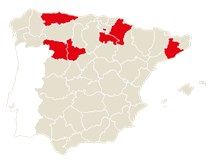Spain enjoys a gentle and sunny climate, which has made it Europe’s greenhouse for centuries. The Arabs perfected the irrigation systems set up by the Romans, importing sophisticated oriental hydraulic techniques. Their amazing water economy allowed them to improve the efficiency of harvests. And when Spain discovered America it started bringing back fruits and vegetables that surprised and delighted the whole world and now form part of its diet.
Until the 1960’s, the agricultural sector was the pillar of the national economy. And although the structure of the Spanish economy has changed considerably in the past half century – today only 5% of the population works in agriculture – Spain is still Europe’s greenhouse and leads the international fruit and vegetable commerce.
The excellent use of water resources and technological advances, have allowed us to find our space among the main fruit and vegetable producers of the world. Greenhouse farming (in the south and the Canaries) has been noticeably perfected. And all throughout the Mediterranean arch and Extremadura the complex irrigation systems have revolutionized farming. This, along with the sun which shines permanently on our country yield excellent harvests all year round.
The Spaniards started exploiting this “green gold” a long time ago exporting their fruit and vegetables to the world. But the best way to reach even further was through canned vegetables. It is no coincidence that the areas that produce the majority of these products are located in the main agricultural regions. In this sense, three production areas stand out: (Albacete and the regions of Murcia and Valencia), the northeastern strip (Navarra, La Rioja and Aragón) and the south west of the Peninsula (Andalucía and Extremadura).
Every year, 1.9 Mill. T of canned vegetables for a value of approximately euros 1.818 Mill. are produced. The fruit and vegetable processing sector consists of 340 companies employing over 30,000 workers, not taking into account the thousands of day laborers who are hired during the harvesting seasons. Ever since its beginning, the industry has been export-oriented. Currently it exports nearly 55% of its production (45% of its total revenue).
Ever since its beginning, the canning industry has been exportoriented. Currently it exports nearly 55% of its production (45% of its total revenue)
The products it manufactures (excluding fruit juices and pickles) are classified into 3 main groups: canned fruit, vegetables and tomato. Canned tomatoes account for 45% of all produced volume (and 38% of the revenue). This vegetable not only is of great importance in Spanish cuisine, which uses it as a base for all its stews and sauce bases, but its worldwide demand has never decreased since the Spaniards brought it from the Americas in 1540, introducing it to Europe. It was so well received that in Italy to this day they call it golden apple (pomo d’oro) and the French named it the apple of love (pomme d’amour). The tomato-producing subsector primarily manufactures tomato concentrate, peeled tomato, tomato puree and tomato juice.
The quality and variety of the fruit produced in our country is also reflected in the processing industry. Canned fruit represents 33% of the overall volume and 27% of the sector’s revenue. The most sought-after canned fruits are peaches, followed by tangerines, apricots, pears, strawberries and mixed fruit. In this subsector, the production of jams and marmalades is of great significance. A popular Spanish breakfast includes coffee and toast with either strawberry, peach, plum or berries jam or even more interesting flavors such as figs or tomatoes.
Vegetables bring color and vitamins to any dish. It is not unusual in a bar to order a canned pepper salad with canned tuna, or a Spanish potato salad (called Russian salad, a star tapa dish) made with canned vegetables. Some outstanding canned vegetables are artichokes, mushrooms, peppers and asparagus. And although some are suffering from competition from the Far East or Latin America, their exquisite taste sets them apart. Canned vegetables account for 19% of the volume and 31% of the revenue of the canning industry.
The main recipient is the EU, primarily Germany, followed by the USA. However the presence of Spanish fruit and vegetables – either canned, frozen or processed – in other parts of the world like South America, Central America, Asia and the Middle East is greater every day.
The broad range of products, the high guarantees of food health and safety that the Spanish industry has to offer, place it at the head of the world canning industry. Furthermore, great modernization advances have taken place, and it has permanently adapted to current consumer trends with noteworthy investments in research, development and innovation of technological centers.
In the past years we have witnessed breathtaking advances in preparation, refrigeration, packaging, preservation and traceability of these foods. Prepared meals, for example, have made a giant leap, and one can now enjoy ready-made meals that taste homemade. On the other hand, recent demand for organic products has been met by the industry, which has been developing organic ranges of products for some time now.

